The term “Ice Age” probably brings to mind an ill-tempered mammoth, a fast-talking sloth, a sarcastic saber-toothed “tiger,” and a bunch of other prehistoric characters from the famous franchise of the same name. Amid the zany events of the franchise’s storyline, it can be easy to forget that the Ice Age was a real event in our planet’s history that forever reshaped the earth. Figuring out how and when the deep freeze took over the earth, what effect it had on plant and animal life, and how it came to an end has taken old-earth and young-earth advocates alike on an incredible journey of discovery into the planet’s frigid past.
The views expressed in this article reflect those of the author mentioned, and not necessarily those of New Creation.
Was There REALLY An Ice Age?
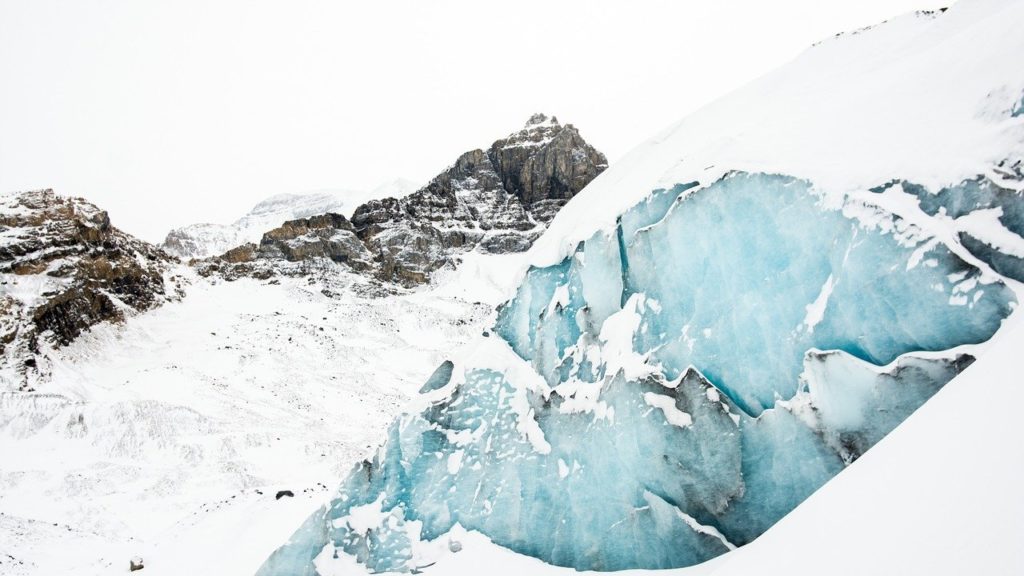
“Well, why not call it The Big Chill? Or the Nippy Era? I’m just saying, how do we know it’s an ice age?”
Ice Age, 2002
“Because of all the ice!”
Contrary to popular belief, the Ice Age was more than just a time when loads of ice and snow covered the earth. Geologists use this term to refer to a period of time when large portions of the world are covered in ice sheets1. Technically, we are in an ice age today because we have ice sheets covering much of Greenland and Antarctica. Old-earth geologists believe that there have been five major ice ages in earth’s past. However, we generally use the term “ice age” in association with what is known as the Pleistocene, or Quaternary, Ice Age. To differentiate the two, we will use the capitalized term, Ice Age, to refer to the events pertaining to the Pleistocene specifically.
By looking at the evidence modern glaciers leave behind when they move to and fro across the landscape, glaciologists (scientists who study glaciers) can determine the extent of Ice Age glaciers. Let’s look at a few indicators of glacial activity.
Indicators of Glacial Activity
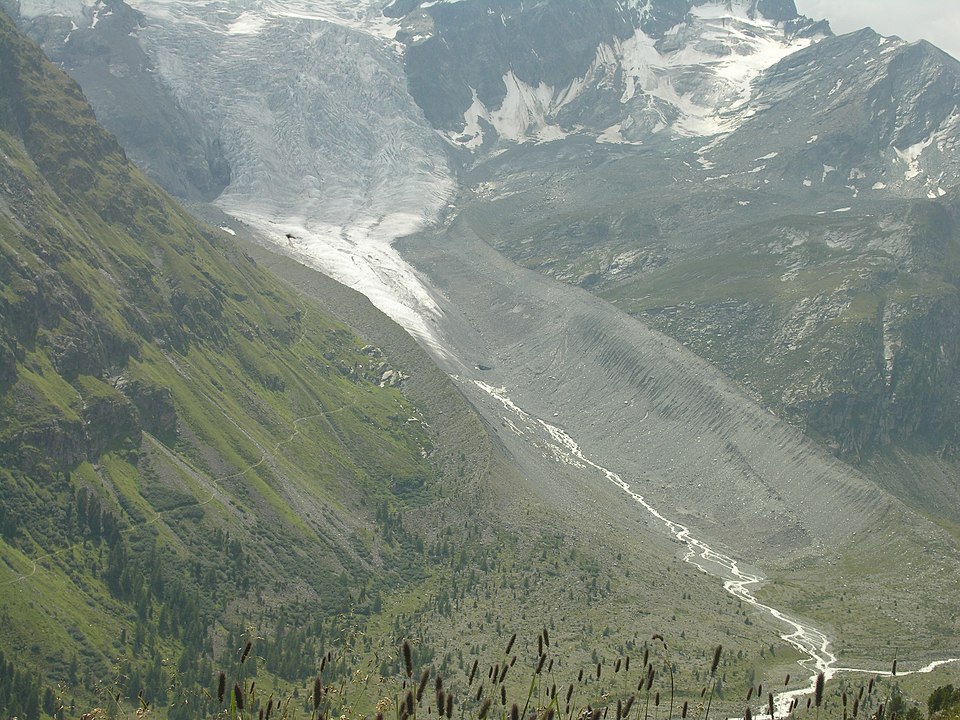
Moraines are piles of unconsolidated (loose) sediment that is shoved out of the way as a glacier advances forward; moraines pushed forward are called terminal moraines, while moraines formed along the sides of a glacier are called lateral moraines.
Glacial Striations are the smoothed and etched surface of a rock that has been overrun by heavy glaciers.
Image Credit: By Arild Vågen – Own work, CC BY-SA 3.0, https://commons.wikimedia.org/w/index.php?curid=21243020
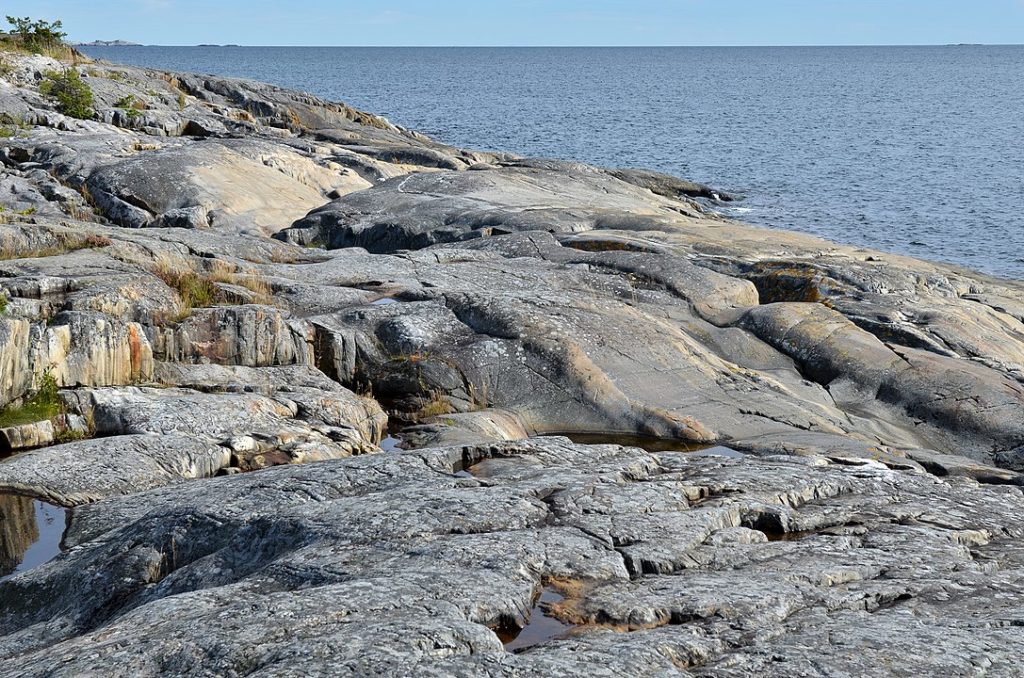
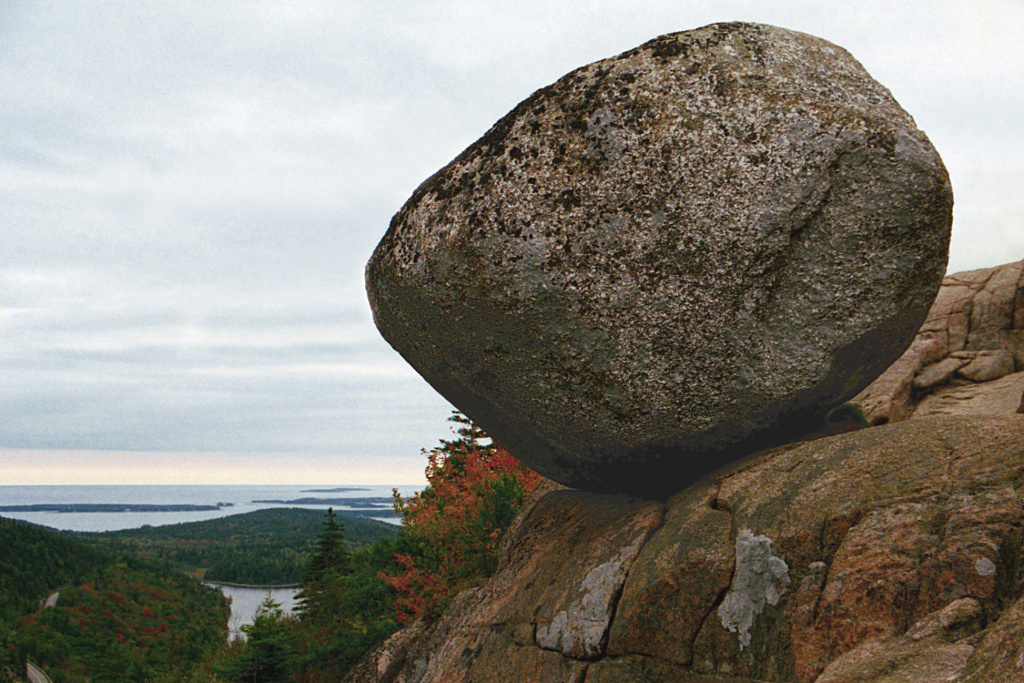
Erratic boulders are rocks that were moved along by advancing glaciers and deposited as the glaciers melted and receded, often ending up many miles from their place of origin; they can range in size from pebbles to very large rocks, like Bubble Rock in Acadia National Park in Maine.
Image Credit: By Brian W. Schaller – Own work, FAL, https://commons.wikimedia.org/w/index.php?curid=30542028
By studying these and other clues, geologists and glaciologists have determined that the Quaternary ice sheets covered about 30% of the earth’s total land surface, mostly in North America, northern Eurasia, and Antarctica. At its maximum extent, the North American ice sheets covered two-thirds of the continent, including most of Canada and extending as far south as the Midwest in some places.
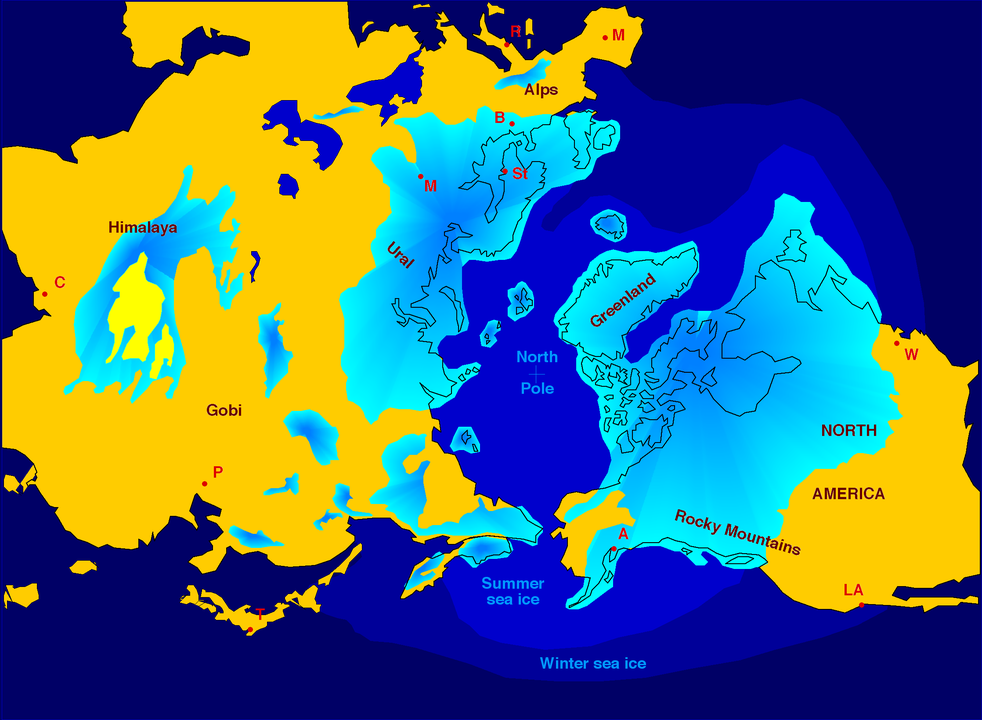
Image Credit: Hannes Grobe/AWI – own work – redrawn, supplemented and modified grafic from John S. Schlee (2000) Our changing continent, United States Geological Survey., CC BY 2.5, https://commons.wikimedia.org/w/index.php?curid=973487
When Did the Ice Age Happen?
Old-earth geologists believe the Quaternary Ice Age was a recent phenomenon in geologic history (relatively speaking), starting about two and a half million years ago and ending as few as 11,000 years ago. But this date range was arrived at based upon old-earth assumptions2. Assuming Genesis 1-11 in the Bible as an eyewitness account of the planet’s past, the world itself would only be a few thousand years old3. How might we determine when the Ice Age occurred in this biblical timeline?
Geology Says…
Geologic formations associated with the Ice Age tend to be localized and preserved in the topmost portions of the geologic record4. This contrasts to the thick and widespread sediment packages most young-earth geologists associate with the Flood. Geologists find these further down in the geologic record. That would indicate that the Ice Age occurred sometime after the Flood.

Image Credit: U. S. Fish and Wildlife Service – Northeast Region – https://www.flickr.com/photos/usfwsnortheast/5278273542/, Public Domain, https://commons.wikimedia.org/w/index.php?curid=51925758
Paleontology Says…
The paleontological record of the Ice Age is also of relevance. Among the mammoths and saber-toothed cats commonly associated with this period, we also find the remains of animals and plants that are still alive today, like cottontail rabbits, coyotes, cougar, white-tailed deer, and pronghorn “antelope,” often living in the exact same places they do today5. Researchers do not find these species in Flood or pre-Flood deposits, meaning that they likely did not exist before the Flood. They must be the post-Flood descendants of the created kinds of animals aboard the Ark with Noah and his family. As such, their presence in Pleistocene deposits is another line of evidence that the Ice Age occurred after the Flood6.
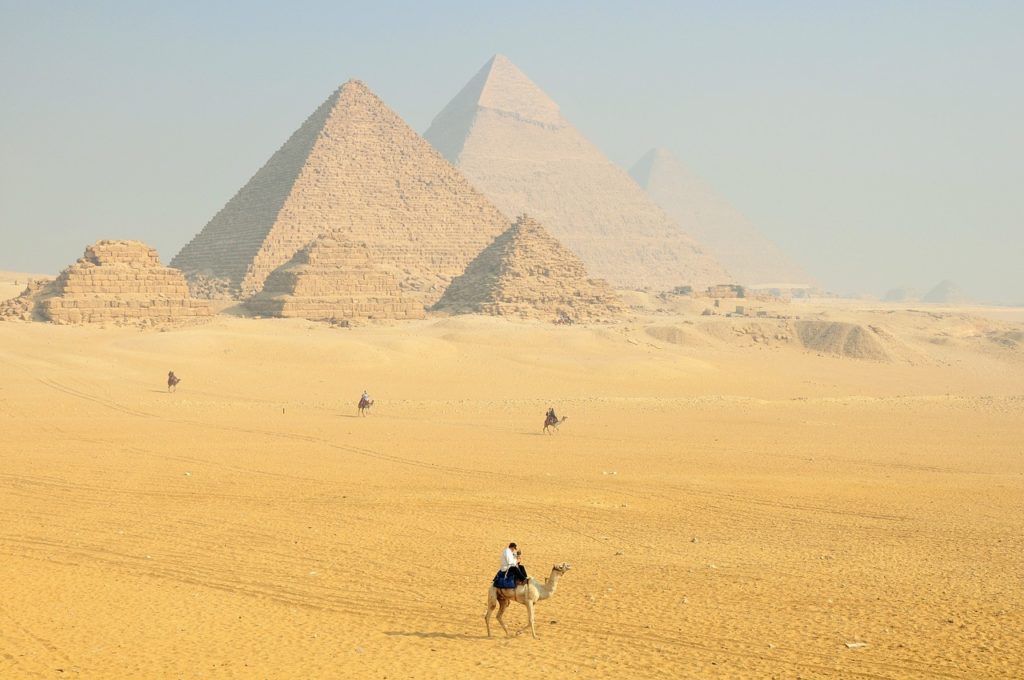
Image Credit: Nadine Doerlé from Pixabay.
Archaeology Says…
Finally, the archaeological record of humans helps us determine the Ice Age’s place in biblical history. There may7 or may not8 have been some overlap between the end of the Ice Age and the building of post-Flood cities. However, we do know that the Ice Age was already well underway by the time complex civilizations arose (with the possible exception of Babel9) because they are absent from Ice Age geologic deposits.
We find the first mention of recognizable and settled civilizations in the biblical account of Abraham. He comes across several powerful nations and city-states, such as Egypt (Genesis 15:19-21), in his journeys through the ancient near east. The account describes these civilizations as prominent and well-established by Abraham’s time, and they post-date any major effect the Ice Age had on these regions. This would indicate that the Ice Age had at least begun, if not already ended, by the time of Abraham.
With this information, we can deduce that the Ice Age would have happened within the centuries to a thousand years or so between the Flood and the time of Abraham.
What About the “Ancient Ice Ages”?
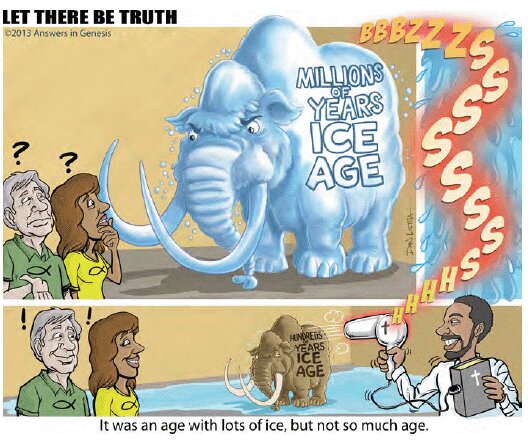
As mentioned above, old-earth geologists believe in not one, but five major ice ages in the earth’s past. How can we understood these from a young-earth perspective?
In general, it is increasingly more difficult to study geologic events the deeper into geologic history one goes. The evidence is even contradictory in many cases. For example, secular researchers have claimed that the Cryogenian ice age, supposedly occurring between 720 and 635 million years ago, covered the entire earth in ice sheets, from the poles to the Equator. researchers have called this idea the Snowball Earth hypothesis. However, there has been research that suggests these “glacial” deposits were associated with sedimentary rocks formed in warm climates10 and fossil sponges11. This indicates the presence of warm, liquid water.
Young-earth research regarding “ancient ice ages” is still in its infancy, but it has been suggested that the ‘evidence’ in support of the Snowball Earth hypothesis is more consistent with that of underwater landslides during Creation Week and/or the Flood12, 13.
How Did the Ice Age Occur?
Most old-earth scientists use the Milankovitch Cycle to explain the occurrence of ice ages. Accordingly, this model argues that the earth’s distance from the sun varies, circling nearer or farther from the sun for thousands of years at a time. When farther from the sun, the earth’s average temperature decreased, allowing snow and ice to accumulate on the continents. This scenario is problematic, however, because while a colder, drier world climate would be able to preserve an already-existing ice sheet, it could not generate ice sheets. Such climate conditions would decrease the amount of evaporation, and therefore the precipitation (snowfall) needed for ice sheets to form.
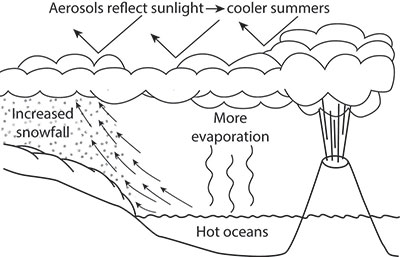
A Creationist Model
The struggles old-earth scientists face to create an ice age has given their young-earth colleagues a chance to develop their own model. By far most of the work in this field has been done by Dr. Michael Oard14. He points out that the tectonic and volcanic activity during the Flood would have left the ocean water much warmer than it is today. This led to increased evaporation, which allowed great quantities of precipitation on land. In some places, this precipitation occurred in the form of rain. In the high latitudes and mountain regions, however, it fell as snow. Over the decades and centuries that followed, the snow piled up into massive sheets of ice and covered large plots of land, lowering sea levels worldwide in response.
Subsequent research by Dr. Steve Gollmer has shown that volcanic activity during and after the Flood may have pumped aerosols, dust, and other debris into the atmosphere, blocking out much of the sun’s heat and cooling the continents15.
Dr. Oard’s Ice Age model suggests that the Ice Age reached glacial maximum (farthest extent of glaciers) within 200 to 1,700 years after the Flood.
How was the Ice Age World Different Than Today?
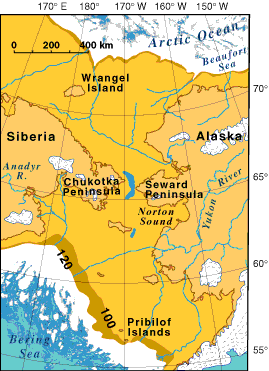
Sea Levels and Land Bridges
Contrary to popular belief, the ice sheets and frigid conditions did not cover the entire world during the Ice Age. Nevertheless, the Ice Age and the conditions that caused it were still worldwide in their influence.
So much of the earth’s water froze on land that sea levels worldwide were hundreds of feet lower than they are today. This exposed vast stretches of shallow seafloor, enlarging landmasses and even forming land bridges in between continents. This allowed animals and plants to freely spread across many regions of the world that oceans now separate. One of these land bridges, called Beringia, once formed between Siberia and Alaska. Sundaland is another example, connecting the islands of Sumatra, Borneo, and Java to mainland Asia.
Lowland Plains and Wet Deserts
Another side effect of the warm post-Flood oceans was that sea ice was unable to form over the Arctic Ocean. Moist, warm air rising from the ocean would have flowed over land, keeping lowland areas from freezing over16. This provided the necessary conditions for vast and lush grassy plains in the high latitudes that were somewhat like today’s African Serengeti, and just as rich in biodiversity17. Known as the Mammoth Steppe, this unique habitat stretched across much of northern Eurasia, Beringia, Alaska, and even some of Canada.
In the late Ice Age, as well as sometime afterward, the Sahara received copious amounts of precipitation as well, turning it into a “wet desert” home for animals and plants that are found much farther south today18. You may be familiar with how tall mountain ranges can restrain precipitation-producing weather systems, forming rain belts. The Ice Age glaciers acted in a similar way. Ice sheets in North America, for example, blocked moisture-laden jet streams coming from the Pacific Ocean and sent them southward. As with the Sahara, the American southwest was also turned into a wet desert with many large lakes and plentiful vegetation19.
What Lived During the Ice Age?
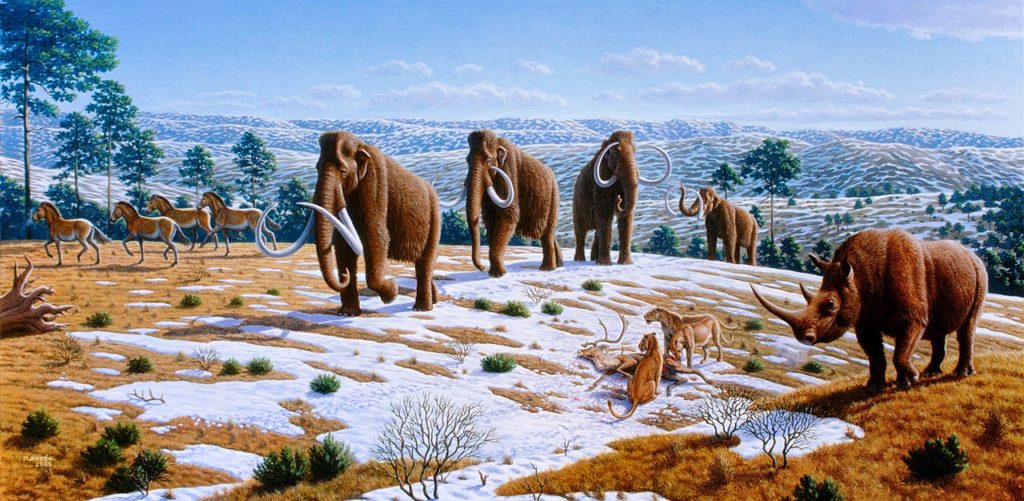
As mentioned above, many of the animals alive during the Ice Age were the same as those still alive today. Thanks to the moist climate of this time, many animals had much broader distributions than they do today. Tapirs and capybaras, for example, flourished throughout the southern United States, while their present day counterparts are only found in Central and South America20, 21.
But there were also animals unique to this period of time called the Pleistocene megafauna. They were large, often many times larger than their closest modern relatives. Great herds of woolly mammoths, bison, and woolly rhinoceros roamed the Mammoth Steppe in droves alongside cave hyenas and steppe lions22. In the Americas, saber-toothed cats, short-faced bears, and dire wolves were among the top predators south of the ice sheets. Glyptodonts (car-sized armadillos), ground sloths, and elephant-like creatures called gomphotheres flourished in these parts as well. Australia’s Pleistocene megafauna was particularly unique. Among them was the giant “wombat” Diprotodon, giant kangaroos, and an enormous sister species of the Komodo dragon called Megalania.
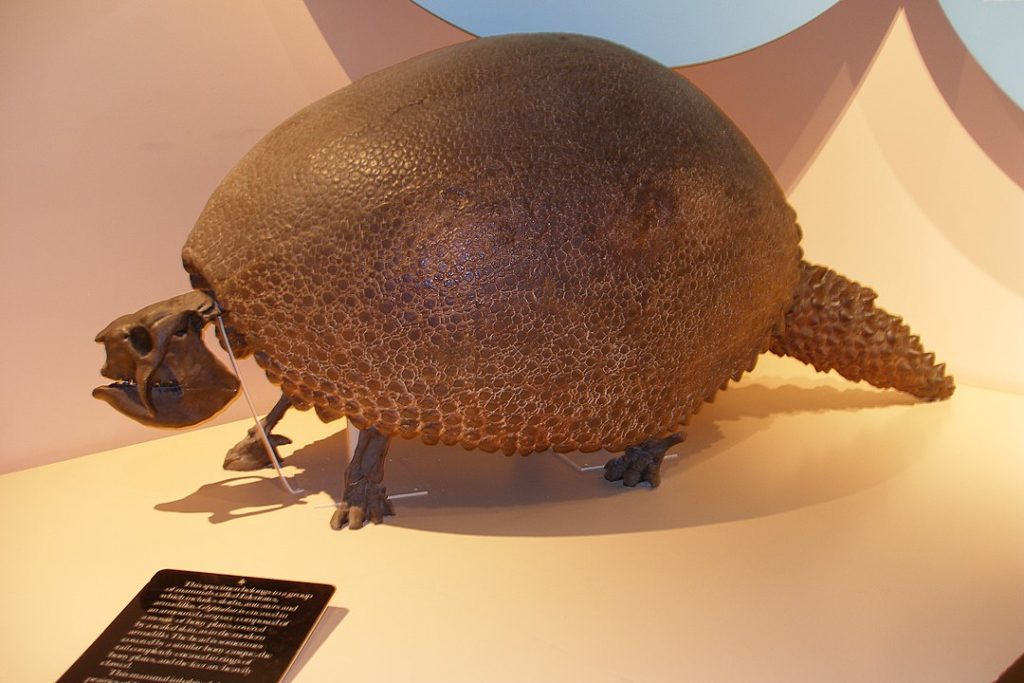
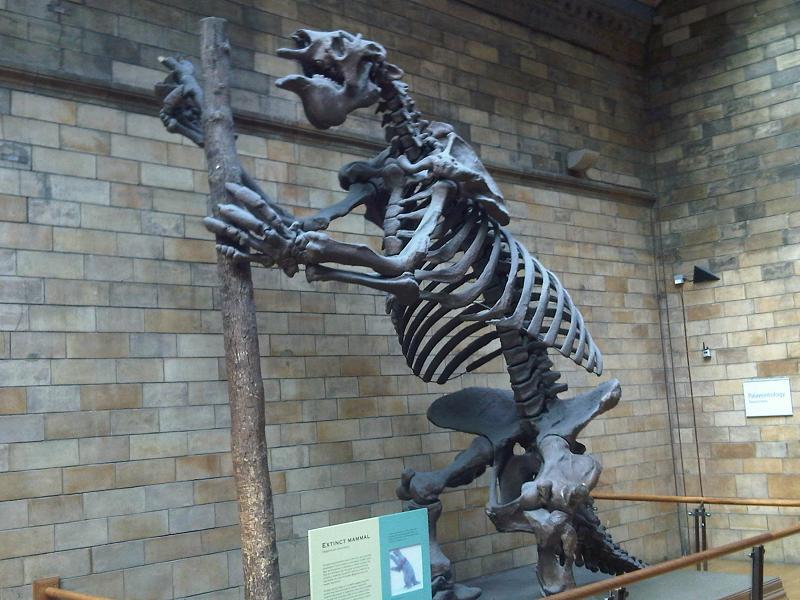
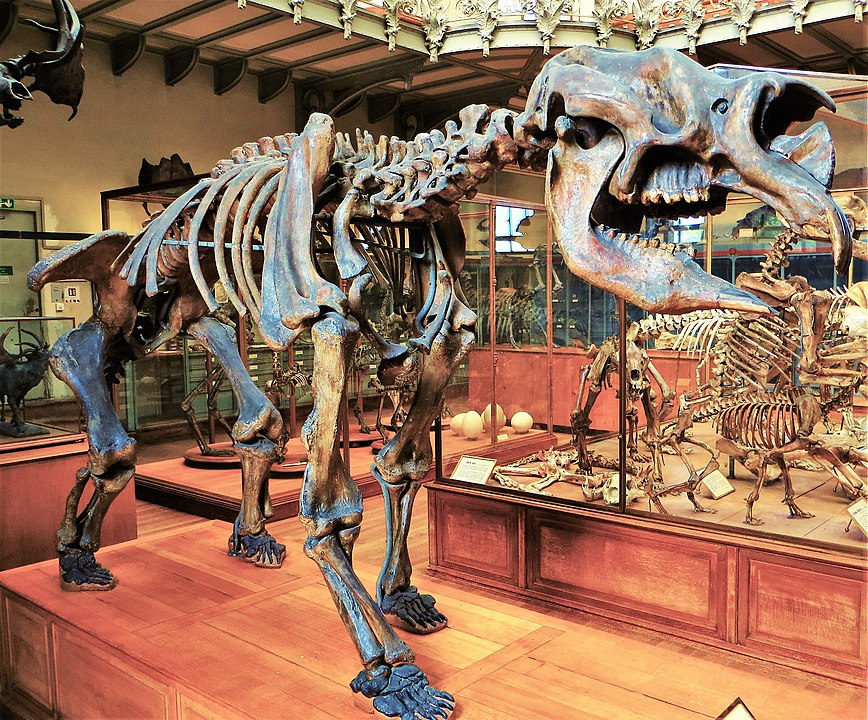
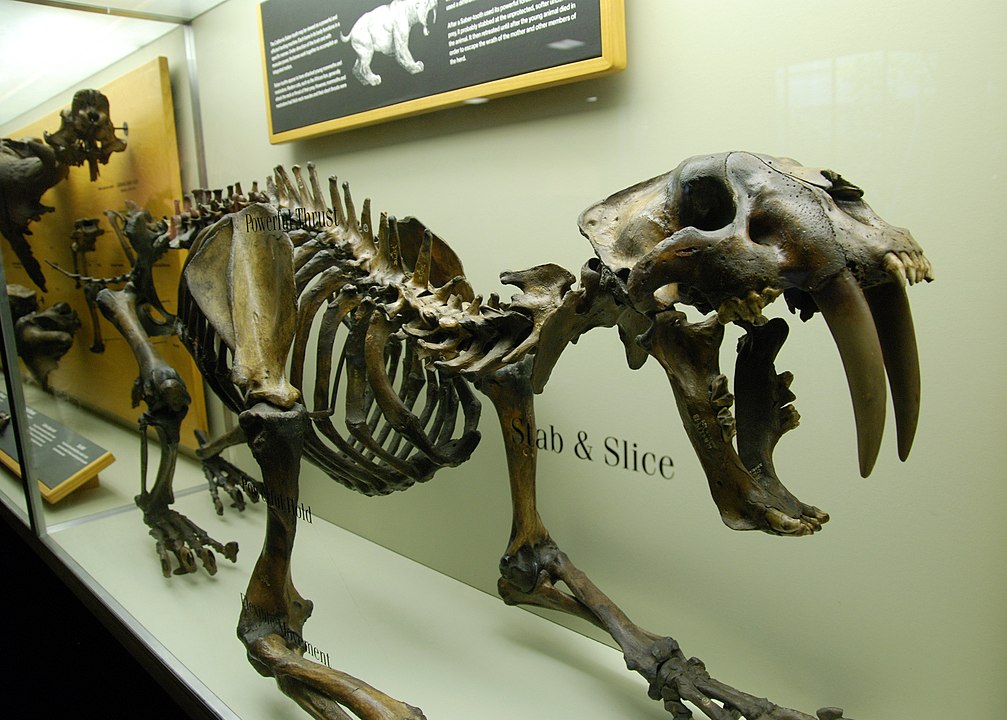
Image Credit: Thomas Quine – Pre-historic armadillo, CC BY 2.0, https://commons.wikimedia.org/w/index.php?curid=45943619
Emőke Dénes – kindly granted by the author, CC BY-SA 4.0, https://commons.wikimedia.org/w/index.php?curid=15905129
Ghedoghedo – Own work, CC BY-SA 3.0, https://commons.wikimedia.org/w/index.php?curid=26800680
CC BY-SA 2.0, https://commons.wikimedia.org/w/index.php?curid=3884313
What Were People Doing During the Ice Age?
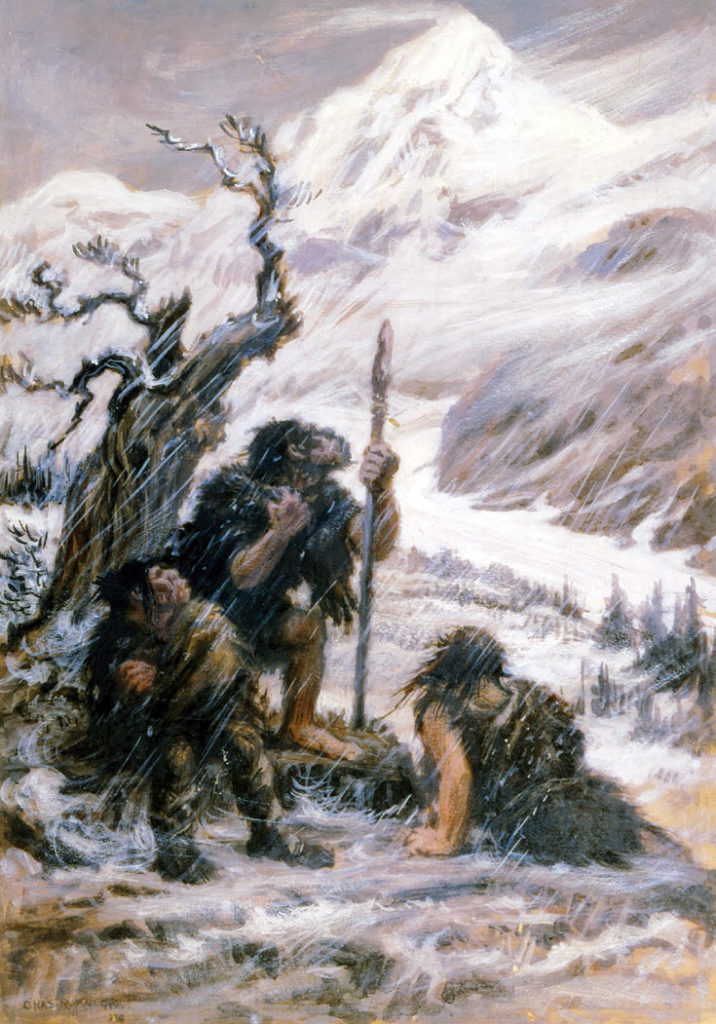
Much like the animals, post-Flood humans also spread out from the Ark and traversed across the planet23. During the Ice Age, most humans were nomadic hunter-gatherers, living in tents or caves. They boasted a wide arsenal of tools made from bone, wood, ivory, antler, and of course stone. Among them were spears and axes used for taking down large game, hammerstones for cracking hard seeds, bones, and nuts, scrapers for preparing animal hides, and awls for making clothing.
Such “primitive” technology may seem out of place; after all, pre-Flood man had previously engaged in agriculture (Genesis 4:2-3) and metallurgy (Genesis 4:21), and had even constructed cities (Genesis 4:17). But we must remember that humans of the Ice Age were living in the aftermath of a technological bottleneck: the Flood! What Noah and his family brought with them in the Ark would have only represented a fraction of the technological prowess that once existed. In addition, it was more practical to adopt the “primitive” hunter-gatherer lifestyle in a world ravaged by unstable environmental conditions in the Flood’s wake.
Diverse Humanity
There were several people groups alive during the Ice Age, all of which descended from Noah and his family24. Some were more like us than others. Neanderthals lived throughout Eurasia and northern Africa. With a stocky body build and large noses that warmed the air before breathing it in, they were well-adapted to thrive in Ice Age conditions. Recent research indicates that Homo naledi was another example of early post-Flood human that may have disposed of their dead in caves. “Hobbits,” Homo floresiensis, were the offspring of post-Flood humans that may have built boats or rafts in order to navigate the islands off the coast of southeast Asia.
For one reason or another, most varieties of humans disappeared sometime before the end of the Ice Age. Only the lineage that leads to us, Homo sapiens, remains. We dispersed widely, not just across Eurasia and Africa, but also Australia, the Americas, and even beyond our planet, with a brief visit to the moon in 1969.
End of the Ice Age
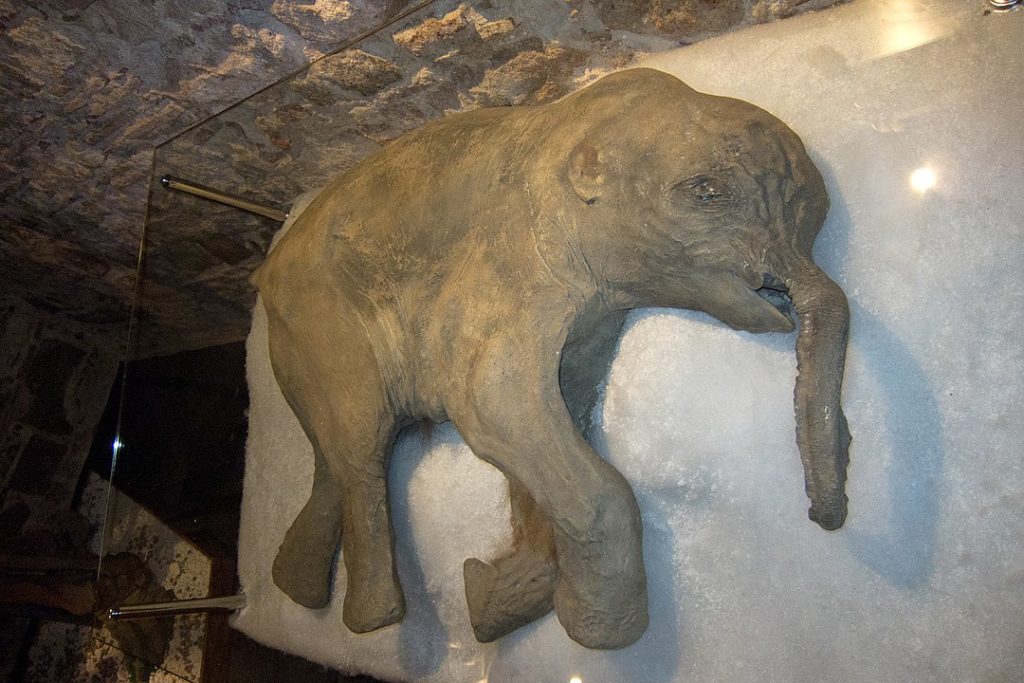
Image Credit: Thomas Quine – Baby Mammoth, CC BY-SA 2.0, https://commons.wikimedia.org/w/index.php?curid=36583200
Just as the mechanisms for the worldwide Flood brought on the Ice Age, their cessation also brought it to an end. When the ocean sufficiently cooled, the ice sheets were no longer supplied with copious amounts of snow25. Volcanic eruptions became smaller and less frequent with time26, meaning more of the sun’s heat was able to enter the earth’s atmosphere. Drying conditions in other parts of the world kicked up severe dust storms that buried animals alive, killing them through asphyxiation27.
Another interesting thing that happened as the Ice Age came to a close is the disappearance of most Pleistocene megafauna worldwide. Paleontologists do not yet agree on why they became extinct and have proposed three theories: overkill, overchill, and overill. Advocates of the overkill theory think humans were to blame, much as we are still causing animals to go extinct today. Those who accept the overchill theory think the end of the megafauna was the result of the climate changes and natural disasters brought on by the Ice Age’s climax. A handful of researchers accept the overill theory, suggesting that the Pleistocene megafauna succumbed to a widespread pandemic. Another possibility is that there was no one cause for the extinction of the Pleistocene megafauna, but a unique combination of the aforementioned theories.
Conclusion
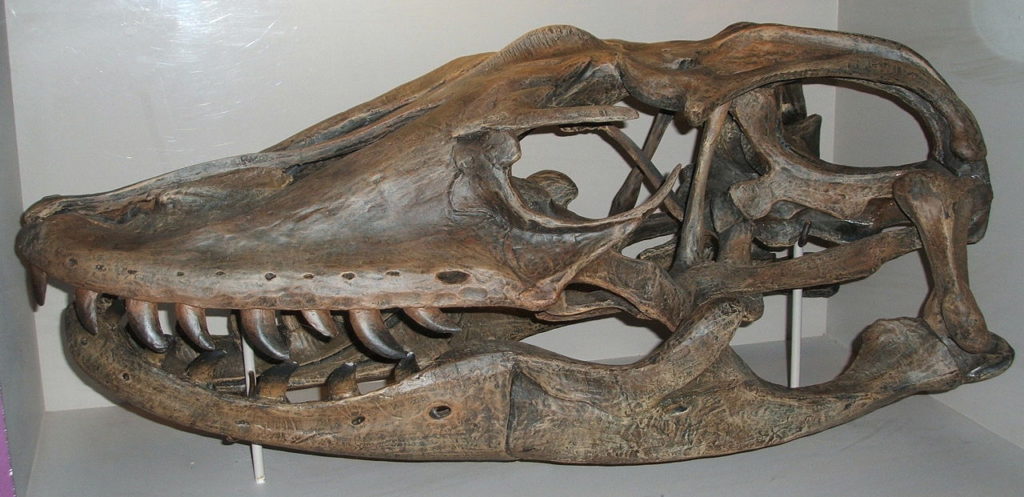
Image Credit: Stevenj, CC BY-SA 4.0, https://commons.wikimedia.org/w/index.php?curid=6532975
The Ice Age was a unique and dynamic time in our planet’s history. In addition, it has given young-earth creationists a perfect launching point for research in the hopes of better understanding it. The Noahic Flood may have provided the necessary starting conditions for an ice age, and the cessation of these mechanisms also could have brought about its meltdown. Today we discussed what effect the Ice Age had on the world, and how it enabled wildlife to recolonize the world after the Flood. We even learned how humans and other animals responded to the major environmental changes stirred up by the Ice Age world.
But as always seems to be the case with science, every answer we get about the Ice Age brings about more unanswered questions. We need a better understanding of how long the Ice Age lasted in the young-earth timescale, especially how long it took the glaciers to advance and recede. Many of the animal kinds that lived during the Ice Age adapted in substantial ways as they adapted to changing climate conditions of the time. Whatever the biological mechanisms were that brought about these changes, they must have operated much more quickly than the slow and gradual mechanisms we observe at work today. What were these mechanisms? We also want to know why almost all of Noah’s descendants (except Homo sapiens) disappeared, and why mammoths, megalania, and other Pleistocene megafauna became extinct.
Such questions can only be answered by young curious minds eager to explore the mysteries of the Ice Age! Care to join the quest?
Footnotes
- Britannica, The Editors of Encyclopaedia. “Ice age“. Encyclopedia Britannica, 16 Dec. 2020. Accessed 27 May 2021. ↩︎
- Oard, M.J., “The challenge of ancient ice ages answered,” Creation 38(1):38–40, 2016; creation.com/ice-age-answers ↩︎
- McGee, David. 2012. “Creation Date of Adam from the Perspective of Young-Earth Creationism.” Answers Research Journal 5 (November 28): 217–230. ↩︎
- Austin, Steven A.; Baumgardner, John R.; Humphreys, D. Russell; Snelling, Andrew A.; Vardiman, Larry; and Wise, Kurt P. (1994) “Catastrophic Plate Tectonics: A Global Flood Model of Earth History,” Proceedings of the International Conference on Creationism: Vol. 3 , Article 56. ↩︎
- Ross, Marcus R. 2012. “Evaluating Potential Post-Flood Boundaries with Biostratigraphy—the Pliocene/Pleistocene Boundary.” Journal of Creation 26, no. 2 (April): 82–87. ↩︎
- Arment, C. (2020). “Implications of Creation Biology for a Neogene-Quaternary Flood/Post-Flood Boundary.” Answers Research Journal 13: 241–256. ↩︎
- Clarey, T. L. 2016. “The Ice Age as a mechanism for post-Flood dispersal.” Journal of Creation. 30 (2): 48-53. ↩︎
- Snelling, A.A. and Matthews, M. 2013. “When Was the Ice Age in Biblical History?” Answers 8(2):44–52. ↩︎
- Purifoy, T. (2019, May 31). “What is the Evidence for the Tower of Babel?” Is Genesis History? ↩︎
- Young, G.M. 2013. “Precambrian supercontinents, glaciations, atmospheric oxygenation, metazoan evolution, and an impact that may have changed the second half of Earth history.” Geoscience Frontiers 4:247-261. ↩︎
- C. K. ‘Bob’ Brain; Anthony R. Prave; Karl-Heinz Hoffmann; Anthony E. Fallick; Andre Botha; Donald A. Herd; Craig Sturrock; Iain Young; Daniel J. Condon; Stuart G. Allison (2012). “The first animals: ca. 760-million-year-old sponge-like fossils from Namibia”. South African Journal of Science. 108 (1/2). ↩︎
- Oard, M.J. 2016. “The challenge of ancient ice ages answered,” Creation 38(1):38–40. ↩︎
- Dickens, H. 2018. “North American Precambrian geology–A proposed young earth biblical model.” In Proceedings of the Eighth International Conference on Creationism, ed. J.H. Whitmore, pp. 389–403. Pittsburgh, Pennsylvania: Creation Science Fellowship. ↩︎
- Oard, M.J. “A post-flood ice-age model can account for Quaternary features. Origins 17(1990):8-26; Oard MJ. 1 An Ice-Age Caused by the Genesis Flood. ICR Technical Monograph. (El Cajon, CA: Institute for Creation Research, 1990). ↩︎
- Gollmer, S.M., Effects of aerosol distribution on precipitation patterns needed for a rapid ice age; in: Whitmore, J.H. (Ed.), Proceedings of the Eight International conference on Creationism, Creation Science Fellowship, Pittsburgh, PA, pp. 695–706, 2018. ↩︎
- Oard, M. 2000. The extinction of the woolly mammoth: was it a quick freeze? Journal of Creation. 14 (3): 24-34. ↩︎
- Bocherens, H., Pacaud, G., Lazarev, P.A. and Mariotti, A., Stable isotope abundances (13C, 15N-fix) in collagen and soft tissues from Pleistocene mammals from Yakutia: implications for the palaeobiology of the mammoth steppe, Palaeogeography, palaeoclimatology, palaeoecology 126:31–44, 1996; p. 31. ↩︎
- Oard, M.J. 2017. “The problem of the wet Sahara.” Journal of Creation. 31 (1) ↩︎
- Oard, M.J. 2020. “Well-watered Deserts.” Creation 42(2):46–49. ↩︎
- Baskin, Jon; Gervais, P. Darrow; Gervais, Camille J. 2020. “A Late Pleistocene capybara (Rodentia, Caviidae, Hydrochoerinae) from near Houston, Texas, USA, with a brief review of North American fossil capybaras”. Proceedings of the Academy of Natural Sciences of Philadelphia. 167: 57. ↩︎
- Hulbert, Richard Jr. (30 September 2010). “A new early Pleistocene tapir (Mammalia: Perissodactyla) from Florida, with a review of Blancan tapirs from the state” (PDF). Bulletin of the Florida Museum of Natural History. 49 (3): 67–126. ↩︎
- Oard, 2000, 24-34. (Footnote 16) ↩︎
- Wood, T.C. 2016. “An Evaluation of Homo naledi and ‘Early’ Homo from a Young-Age Creationist Perspective.” Journal of Creation Theology and Science Series B: Life Sciences 6:14-30 ↩︎
- Wood, 2016, 14-30. (Footnote 23) ↩︎
- Oard, 1990, 8-26. (Footnote 14) ↩︎
- Austin, S. A. 1998. “The Declining Power of Post-Flood Volcanoes.” Acts & Facts. 27 (8). ↩︎
- Oard, M.J. “Evidence some woolly mammoths asphyxiated from dust.” Journal of Creation 29(3) 2015. ↩︎

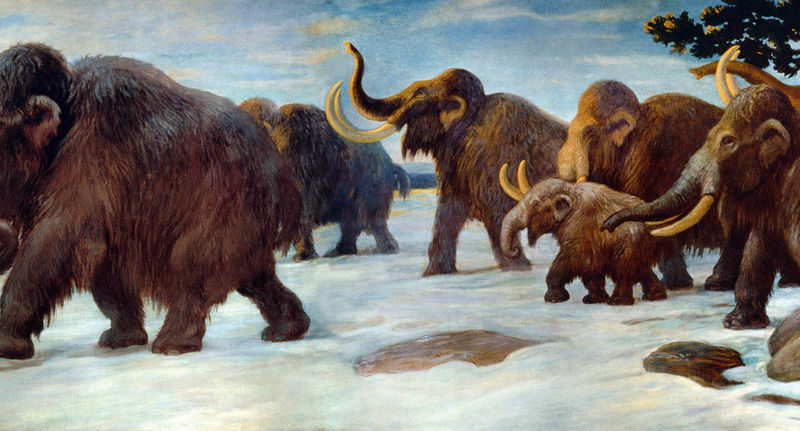



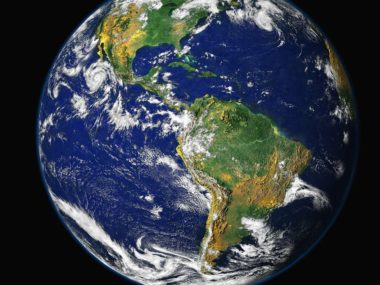

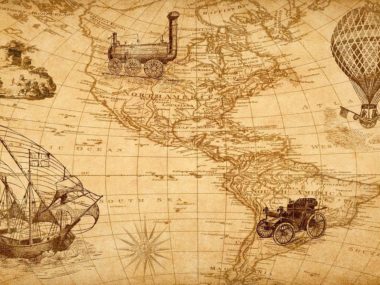




Thank you for this post. I find the ideas and information provided in it very fascinating and instructive. It also makes me wonder, One, what type of human(s) were Noah and his family, and, Two, what was the way(s) of life of that family during the post-Flood Ice Age.
Readers beware. The story of the ice age in this post does not come even close to the reality of evidence in creation. The claim of flood geologists is a 700-year ice age after Noah’s Flood 4,400 years ago. This is a wild speculation without evidence. The reality of ice core data from Greenland shows snowfall for >60,000 years and the last glacial maximum melted away between 15,000 and 11,500 years ago. This diagram shows data of reality.
Ken Wolgemuth
Important and excellent researched article. Also ggod ideas are reported. I love the ice age subject relative to creationism. its a big subject. I suggest it was a fast creation some centuries after the flood, not needing the flood reactions by the way, and volcanic eruptions corrupted the the poles. i suggest the “ice’ was created with weeks or months by freezing rain episodes. the ice age lasted a century or two then melted as quickly as it appeared. All done by 1800BC or so.
Creationists just need to speed things up. i see the ice age as probably allowed by God to fulfill the Japheth prophecy but thats another issue.
There is lots of evidence for the start of the ice age in the death assemblages of non ice age creatures.they show a disastor happened to fossilize them by volcanic ash, like in nebraska, and within weeks the climate changed.
Readers beware. The story of the ice age in this post does not come even close to the reality of evidence in creation. The claim of flood geologists is a 700-year ice age after Noah’s Flood 4,400 years ago. This is a wild speculation without evidence. The reality of ice core data from Greenland shows snowfall for >60,000 years and the last glacial maximum melted away between 15,000 and 11,500 years ago. This diagram shows data of reality.
Ken Wolgemuth
One thing I think, perhaps they are missing in the Ice Age scenario is that the firmament was broken up and fell to the earth. The firmament was probably around the same temperature as space. -454°F. Perhaps when it fell to the earth that would account for the rapid freezing of the woolly mammoth and a mastodon. Some theories the firmament was pulled towards the polls and may have created colder temperatures there that enhanced the speed With which the snow and ice sheets were generated.
Thanks for your thoughts. We did not consider the possibility that the firmament caused the Ice Age in this article because it is scientifically problematic. Firstly, the Ice Age appears to have happened after the flood, not before or during it. If this is correct, the Ice Age cannot be the direct result of the collapse of the firmament. Secondly, all known models of a liquid, solid or vapor canopy around the earth are very problematic. The issue is that having water in a canopy would cause the earth to overheat to excessive levels before the Flood. For this reason, most creationists have now abandoned canopy theory for alternate interpretations of the firmament. For more information on that, check out this article: https://answersingenesis.org/environmental-science/state-of-canopy-model/